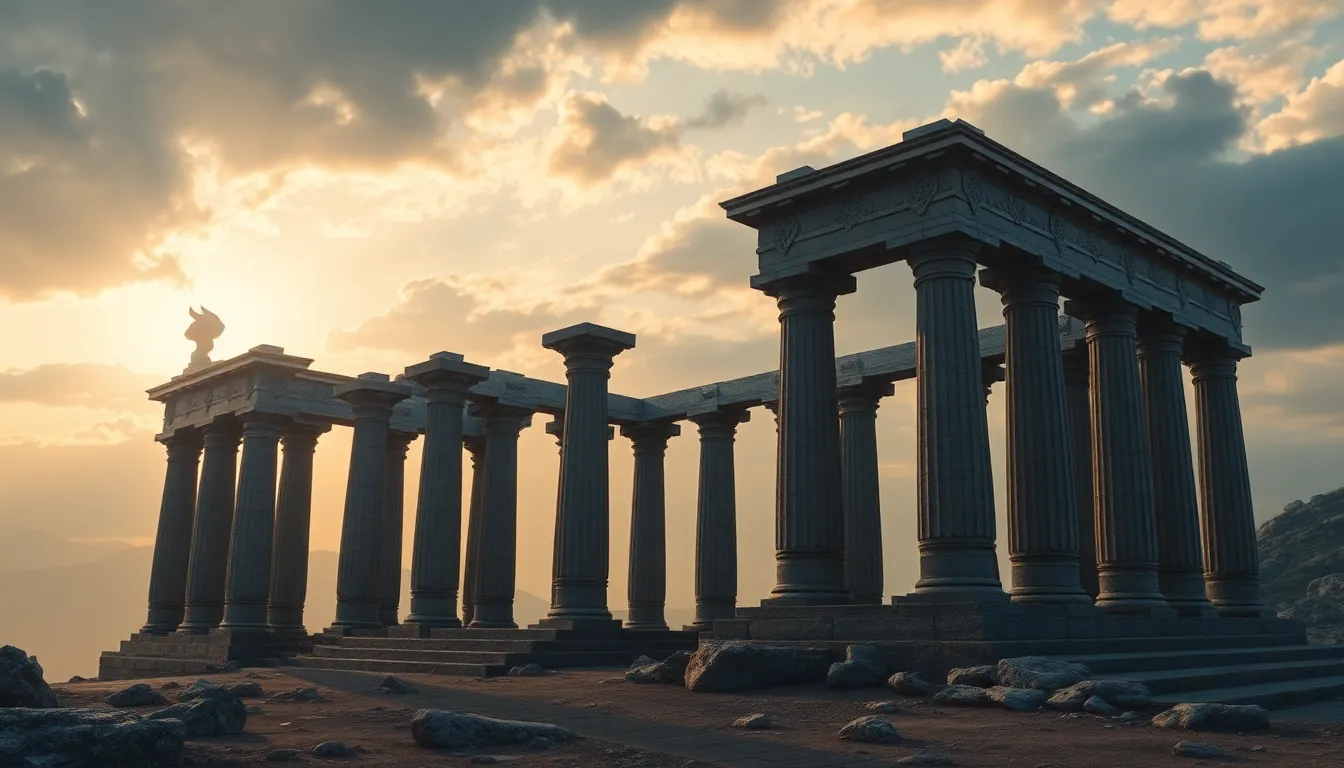The Pillars of Myth: Sacred Structures That Inspire Awe
I. Introduction
Myth serves as a powerful narrative force across various cultures, encapsulating the beliefs, values, and histories of societies. At its core, a myth is a traditional story that explains natural or social phenomena, often involving supernatural beings or events. Myths are not merely tales; they shape worldviews and influence the way people interact with their environment, including the sacred spaces they create.
Sacred structures, including temples, shrines, and other edifices, play a vital role in the manifestation of these myths. They serve as physical representations of cultural beliefs and spiritual practices, creating spaces where the divine and the mundane intersect. This article aims to explore the intersection of myth and architecture, delving into how sacred structures embody cultural narratives and inspire awe.
II. The Concept of Sacred Structures
Sacred structures are more than mere buildings; they are imbued with significance and meaning. Their characteristics often include:
- Symbolism: Each element of a sacred structure can carry deep symbolic meaning, reflecting the beliefs of the culture it represents.
- Location: Sacred sites are often strategically placed in locations that have historical or spiritual significance.
- Materials: The materials used in construction may be chosen for their symbolic importance or rarity.
- Design: The architectural style often reflects the aesthetic values and technological capabilities of the culture.
Across cultures, sacred structures manifest in various forms including temples, shrines, churches, and mosques. These edifices serve dual roles—both physical and spiritual—acting as places for worship, community gathering, and personal reflection.
III. The Role of Myths in Shaping Sacred Architecture
Myths profoundly influence the design and symbolism of sacred structures. They provide a narrative foundation upon which architectural forms are constructed. For example, many temples are designed according to specific mythological principles, guiding the layout and ornamentation.
Consider the following case studies of notable structures inspired by local myths:
- The Temple of Angkor Wat: This massive temple complex in Cambodia is not only a feat of engineering but also a representation of the Hindu cosmology.
- The Sagrada Familia: Antoni Gaudí’s masterpiece in Barcelona draws heavily from Christian themes and biblical stories.
- The Parthenon: Dedicated to the goddess Athena, its design is steeped in the mythology of Ancient Greece.
The relationship between myth, narrative, and architectural form is intricate. Myths inform how spaces are utilized and experienced, creating environments that resonate with spiritual and cultural significance.
IV. Ancient Wonders: Pillars of Mythology
Throughout history, numerous structures have emerged as pillars of mythology and culture. Some notable examples include:
- The Parthenon: This iconic structure symbolizes the glory of Ancient Greece, dedicated to Athena, the goddess of wisdom and war.
- The Great Pyramid of Giza: Linked to myths of the afterlife, this pyramid reflects the Egyptians’ beliefs about death and resurrection.
- Stonehenge: This prehistoric monument is surrounded by celestial myths and is believed to have been a site for ancient rituals.
V. Sacred Structures in Eastern Mythologies
Eastern mythologies have produced a wealth of sacred structures that reflect unique spiritual concepts. For instance:
- Hindu Temples: Hindu architecture is rich with symbolism, where every aspect of a temple is designed according to sacred texts and cosmic principles.
- Buddhist Stupas: These structures symbolize the universe and the path to enlightenment, often housing relics of the Buddha.
- Chinese Pagodas: Combining functionality with mythological symbolism, pagodas often represent the connection between heaven and earth.
VI. Indigenous Sacred Structures and Their Myths
Indigenous cultures have also created sacred structures that carry deep mythological significance. Examples include:
- Totem Poles: In Native American cultures, totem poles represent ancestral spirits and cultural narratives.
- Earth Mounds: Used by ancient civilizations, these structures often served ceremonial purposes and were tied to local myths.
- Machu Picchu: This iconic site is surrounded by myths related to Incan cosmology and spirituality.
VII. The Modern Interpretation of Sacred Structures
Contemporary architecture continues to draw inspiration from ancient myths. Modern sacred spaces often incorporate mythic themes to create environments that resonate emotionally with visitors. Examples include:
- The Crystal Cathedral: A modern take on sacred space that uses glass to reflect light and symbolize spirituality.
- The Chapel of St. Ignatius: Designed by Robert Venturi, this chapel reflects Jesuit ideals and draws on narrative forms.
- St. Nicholas Greek Orthodox Church: This church, rebuilt after the 9/11 attacks, reflects resilience and draws on rich Byzantine tradition.
VIII. The Emotional and Psychological Impact of Sacred Structures
The presence of sacred architecture often evokes feelings of awe and inspiration. The psychological connection between myth and architecture can foster a sense of belonging and identity within communities. Sacred structures:
- Encourage reflection and spiritual growth.
- Serve as communal gathering places, strengthening social bonds.
- Provide a physical manifestation of cultural identity and continuity.
IX. Challenges and Preservation of Sacred Structures
The modernization of society poses significant challenges to the preservation of sacred sites. As urbanization and development encroach on these spaces, it is crucial to consider:
- The impact of tourism and commercialization on sacred sites.
- Conservation efforts that respect the mythic narrative of these structures.
- The need for ongoing education about the cultural significance of sacred sites.
X. Conclusion
Sacred structures serve as enduring pillars of myth, inspiring awe and connecting us to the stories of our ancestors. They reflect the intersection of architecture and narrative, embodying the beliefs and values of their cultures. As we navigate the challenges of modernity, preserving these sites is essential for maintaining the rich tapestry of human history and spirituality.



